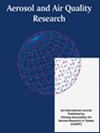一种生成不同尺寸窄分散生物气溶胶的简单方法
IF 2.5
4区 环境科学与生态学
Q3 ENVIRONMENTAL SCIENCES
引用次数: 0
摘要
生物战剂(BWAs)在有目的地分散在一个地区时,会引起人类、动物和植物的疾病。为了尽量减少污染和人员接触并开始早期治疗,需要有效的BWA检测或监测技术。目前,生物气溶胶检测或监测技术用于检测BWA;然而,这些技术有局限性,比如有限的灵敏度。为了提高检测性能和开发新技术,需要在样品制备中增加一个步骤,例如获得各种大小的颗粒。在这项研究中,我们研究了使用定制的喷墨气溶胶发生器(IJAG)简单有效地产生生物气溶胶颗粒。与以往的喷墨气溶胶发生器不同,IJAG的工作条件为喷嘴加热温度140℃,驱动电压150 V,脉冲宽度60µs,频率250 Hz。唯一受控制的因素是生物气溶胶模型的浓度,包括球状芽孢杆菌孢子、卵清蛋白和聚苯乙烯球乳胶。我们的系统生成的生物气溶胶直径为1-8微米,分布尺寸较窄。这些结果表明,我们的IJAG系统可以为广泛的可用材料实现简单和通用的窄分散生物气溶胶生成。我们的研究有助于提高生物农药和生物气溶胶检测和监测系统的灵敏度。本文章由计算机程序翻译,如有差异,请以英文原文为准。
A Simple Method for Generating Narrowly-dispersed Bioaerosols in Various Sizes
Biological warfare agents (BWAs) cause disease in humans, animals, and plants when purposefully dispersed in an area. To minimize contamination and personnel exposure and initiate early treatment, effective BWA detection or monitoring techniques are needed. Currently, bioaerosol detection or monitoring techniques are used for detecting BWA; however, these techniques have limitations, such as limited sensitivity. To improve the detection performance and develop novel techniques, an additional step in sample preparation, such as obtaining particles of various sizes, is needed. In this study, we investigated the simple and effective generation of bioaerosol particles using a custom-made inkjet aerosol generator (IJAG). Unlike previous inkjet aerosol generators, the operation conditions of the IJAG are fixed at a nozzle heating temperature of 140 ° C, a driver voltage of 150 V, a pulse width of 60 µ s, and a frequency of 250 Hz. The only controlled factor was the concentration of bioaerosol models, including Bacillus globigii spores, ovalbumin, and polystyrene sphere latex. Our system generated bioaerosols with a diameter of 1–8 µ m and a narrow distribution size. These results suggest that our IJAG system can achieve the simple and versatile generation of narrow-dispersed bioaerosols for a wide range of available materials. Our study can help improve the sensitivity of detection and monitoring systems for BWAs and bioaerosols.
求助全文
通过发布文献求助,成功后即可免费获取论文全文。
去求助
来源期刊

Aerosol and Air Quality Research
ENVIRONMENTAL SCIENCES-
CiteScore
8.30
自引率
10.00%
发文量
163
审稿时长
3 months
期刊介绍:
The international journal of Aerosol and Air Quality Research (AAQR) covers all aspects of aerosol science and technology, atmospheric science and air quality related issues. It encompasses a multi-disciplinary field, including:
- Aerosol, air quality, atmospheric chemistry and global change;
- Air toxics (hazardous air pollutants (HAPs), persistent organic pollutants (POPs)) - Sources, control, transport and fate, human exposure;
- Nanoparticle and nanotechnology;
- Sources, combustion, thermal decomposition, emission, properties, behavior, formation, transport, deposition, measurement and analysis;
- Effects on the environments;
- Air quality and human health;
- Bioaerosols;
- Indoor air quality;
- Energy and air pollution;
- Pollution control technologies;
- Invention and improvement of sampling instruments and technologies;
- Optical/radiative properties and remote sensing;
- Carbon dioxide emission, capture, storage and utilization; novel methods for the reduction of carbon dioxide emission;
- Other topics related to aerosol and air quality.
 求助内容:
求助内容: 应助结果提醒方式:
应助结果提醒方式:


